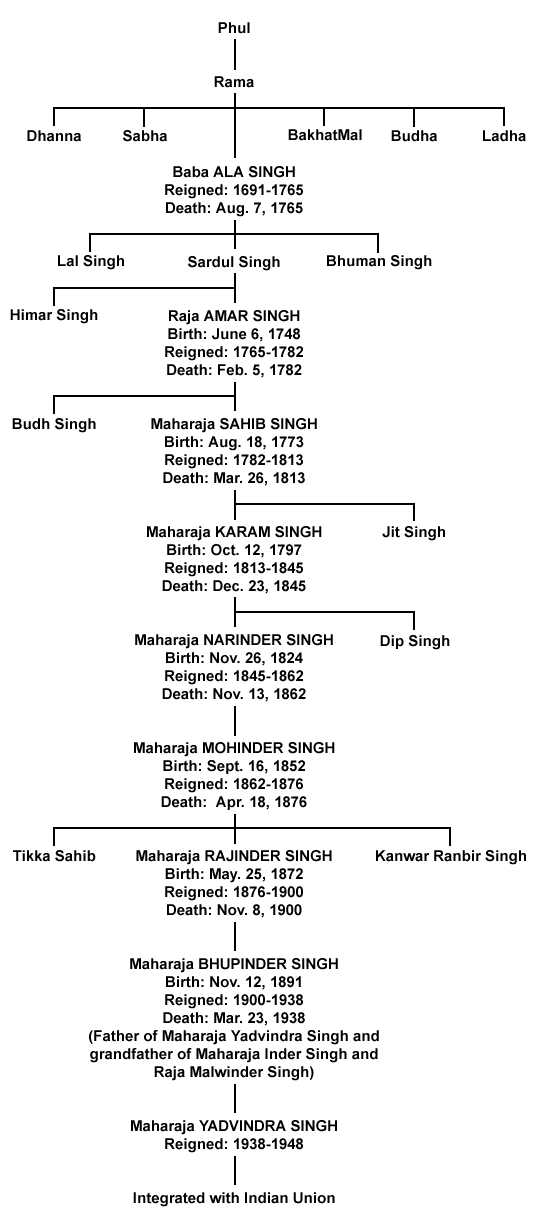8th January
| 1685 | Janam Din, Baba Aalla Singh, founder of Patiala State.
==> BABA AALLA SINGH JI was born in village Phull to father Baba Ram Singh “Phulwansi” and mother Saabhi. He was introduced to amrit by Baba Deep Singh Ji, in TheekriWalae village. In sunmat 1810, he laid the foundation stone of a temporary structure for the Patiala fort while the construction of a permanent structure began in sunmat 1820. Simultaneously he founded the Patiala city. Barnala, Longowal, Sunaam, Bathinda, and Patiala were under his control. He passed away on 22nd Aug. 1765 in Patiala. -Ref. Mahan Kosh ==> PATIALA FAMILY traces its descent to Maharaja Gaj, founder of the town Gazni (now in Afghanistan) in the first quarter of the 16th century. His descendents, Maharawal Jaisal, founded the State of Jaisalmer and his grand son, Rao Hans Raj, is considered the ancestor of Patiala family. However, Tawarikh Guru Khalsa written by Giani Gian Singh, traces the Patiala family descent to Chaudhri Phul, a Sidhu Jat in “Malwa country” and the Chaudhri belonged to the 23rd generation of the family of Bhatti Rajputs. When Bhim Mal came to Punjab in 1237 he helped Shahabuddin Gauri, in his attack on Delhi and in lieu of that, he was given the area comprising of Hissar, Sirsa, etc. In 1251, he built a fort in Hissar town. After his death, his son Jawand Rao succeeded and had 21 sons. According to Giani Gian Singh, Chaudhri Phul, son of Chaudhri Rup Chand, belonged to the family tree belonging to the descendents of Jawand Rao. When Guru Har Rai Patshah visited Malwa in 1702 B.K., Chaudhri Kala, brother of Chaudhri Rup Chand, brought his two nephews, Phul and Sandali to the Guru. On instructions of their uncle, who was acting as their guardian, both Phul and Sandali started beating their bellies and when Guru Sahib asked the reason, Chaudhri Kala explained that his nephews wanted to sariate their hunger. At that time, Guru Sahib blessed and ordained that the Phul family would reign for a considerable period of time and that it would feed lakhs of people. Chaudhri Phul died in 1745 B.K. and was succeeded by his two sons, Talok Chand and Ram Chand, who were introduced to amrit by Guru Gobind Singh in 1761 and were subsequently named Talok Singh and Ram Singh. Because of their great services to Guru Sahib, the two brothers were blessed and the Guru ordained “My house is your house and I am much pleased with you”. Maharaj Ram Singh, who effectively controlled the areas surrounding Patiala, was murdered in 1771 B.K. (1741) at the hands of Chain Singh, Uggar Sain and Biru. He was succeeded by six sons, Baba Ala Singh proved to be the most dominating and promising. He was introduced to amrit by Nawab Kapur Singh. The Patiala family attained prominence during Baba Ala Singh reign, who founded the State of Patiala by defeating the eighboring chieftains. Emperor Shah Jahan conferred the title “Raja” on Baba Ala Singh.
Unfortunately, the Patiala family often acted against interest of the Sikhs. They were often concerned with propagating their own family business interests firs and foremost. Among the damage they did to the Panth was the reinforcement of the Brahminincal tradition of Nirmalae Sikhs and in total disrespect to GurSikh women many Patialites kept countless Ranis, performed anti Sikhi parades, etc. When Gadarites were orgainzing in US and Baba Khadak Singh was pursuing Keys Morcha and Bhai Sahib Randhir Singh was organinsing Rakab Ganj protest, Patialites were busy bootlicking British reprentatives. They offered many naive young rural Sikhs for deployment in Greece, North Africa and Europe, who eventually sacrificed their lives for a war they had absolutely nothing to do with. The Sikhs continously failed to recognize Patialites and remained loyal to them, even during partition talks (when Patiala family’s daughter was to be wed with Dr. Ambedkar’s nephew and 100 million of Dalits who were going to embrace Sikhism were thrown out by a series of calculated malicious events). For these reasons and many more, PATIALA FAMILY were never considered a part of the Khalsa Misls and remained as fringe elements to GurSikh society. -Ref. The Illustrated History of the Sikhs (1947-78), by Gur Rattan Pal Singh |
| 1998 | Gurdwara in Ghaziabad, India demolished by the BJP-led government.
Ghaziabad Development Authority looted and demolished a Gurudwara erected in Vaishali Park. The demolishen was ordered by the local BJP government officials and executed during the mroning prayers around 6:30am. Over 100 policemen cordoned off the area while asa-di-war kirtan in progress and demolished the structure with dulldozers without any warning. Even the saroop of Sri Guru Granth Sahib and Nishan Sahib were not spared. The policemen looted all the jewelry and valuables of the Gurdwara. The Policemen were intoxicated and they verbally abused and beat many of the Sikh families present. women were dragged out of their houses and even the elderly weren’t spared. |
